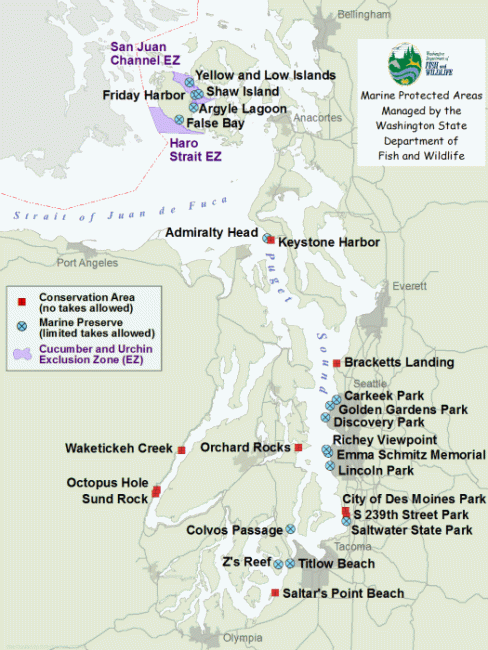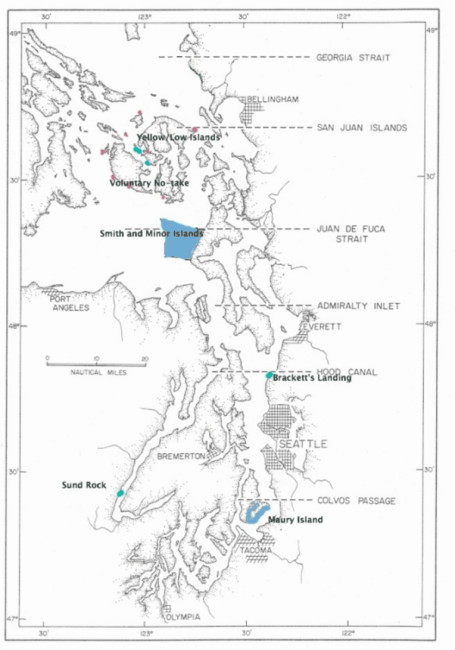Marine Protected Areas in Puget Sound
Marine Protected Areas (MPAs) have been present in Puget Sound since the early 1900s, although most were established after the 1960s. By 1998 there were at least 102 intertidal and subtidal protected areas in Puget Sound, created and managed by at least 12 different agencies or organizations at the local, county, State and Federal level.

 A 2009 inventory found a total of 127 MPAs in Washington, of which 16% were no-take areas in which all resource harvest is prohibited. In addition to areas restricting harvest, some MPAs involve habitat protections or restrict non-harvest activities such as vessel anchoring or recreational access (Van Cleve et al. 2009). There are 110 officially designated MPAs in Puget Sound (366,503 acres and almost 600 miles of shoreline) of which 24 are within the national MPA system (Osterberg 2012).
A 2009 inventory found a total of 127 MPAs in Washington, of which 16% were no-take areas in which all resource harvest is prohibited. In addition to areas restricting harvest, some MPAs involve habitat protections or restrict non-harvest activities such as vessel anchoring or recreational access (Van Cleve et al. 2009). There are 110 officially designated MPAs in Puget Sound (366,503 acres and almost 600 miles of shoreline) of which 24 are within the national MPA system (Osterberg 2012).
 The main forms of Puget Sound MPAs are: no-fishing areas declared by the Washington Department of Fish and Wildlife (WDFW) to improve fish populations and protect habitat (Figure 1), diving/no-fishing reserves spearheaded by SCUBA diving enthusiasts and sanctioned by WDFW (Sund Rock and Brackett’s Landing, Figure 1 and 2), and aquatic reserves declared by WA Department of Natural Resources (WA DNR, Smith and Miner Islands and Maury Island Aquatic Reserves found on Figure 2) to regulate bottomland leasing in critical areas in order to improve marine habitat conditions. The majority of the WDFW MPAs are small and recent in their designation (Table 1). They vary in terms of citizen engagement and frequency of use by recreational SCUBA divers. Conservation Areas are fully protected from non-tribal fishing, whereas Preserves allow for some forms of fishing, usually for salmon with trolling gear (Palsson, pers. comm.). Fifty percent of the sites contain rocky reef habitat utilized by ESA listed rockfish and popular with divers. Some, but not all, of the WDFW MPAs are part of the national MPA system.
The main forms of Puget Sound MPAs are: no-fishing areas declared by the Washington Department of Fish and Wildlife (WDFW) to improve fish populations and protect habitat (Figure 1), diving/no-fishing reserves spearheaded by SCUBA diving enthusiasts and sanctioned by WDFW (Sund Rock and Brackett’s Landing, Figure 1 and 2), and aquatic reserves declared by WA Department of Natural Resources (WA DNR, Smith and Miner Islands and Maury Island Aquatic Reserves found on Figure 2) to regulate bottomland leasing in critical areas in order to improve marine habitat conditions. The majority of the WDFW MPAs are small and recent in their designation (Table 1). They vary in terms of citizen engagement and frequency of use by recreational SCUBA divers. Conservation Areas are fully protected from non-tribal fishing, whereas Preserves allow for some forms of fishing, usually for salmon with trolling gear (Palsson, pers. comm.). Fifty percent of the sites contain rocky reef habitat utilized by ESA listed rockfish and popular with divers. Some, but not all, of the WDFW MPAs are part of the national MPA system.
MPA Name | Date Est. | Area (Hectare) | Level of Citizen Engagement | Dive Usage | Preserve or Conservation Area | Rocky Reef |
|---|---|---|---|---|---|---|
1) Admiralty Head | 2002 | 35.77 | Low | Low | Preserve | Yes |
2) Argyle Lagoon | 1990 | 5.78 | Low- Friday Harbor Labs (FHL) | None, intertidal | Preserve |
|
3) Brackett's Landing | 1970 | 23.81 | High-City of Edmonds, volunteer divers, many other divers | High | Conservation Area |
|
4) Carkeek Park | 2005 | 9.97 | Medium-Seattle Aquarium, Carkeek Park supporters | None, intertidal | Preserve |
|
5) City of Des Moines Park | 1998 | 3.73 | Low | None, intertidal | Preserve |
|
6) Colvos Passage | 2000 | 1.32 | High, Dive clubs | High | Preserve |
|
7) Discovery Park | 2005 | 16.58 | Low, Seattle Aquarium | None, intertidal | Preserve |
|
8) Emma Schmitz | 2005 | 2.56 | Medium-Seattle Aquarium, Carkeek Park supporters | None, intertidal | Preserve |
|
9) False Bay | 1990 | 123.72 | Low- FHL | None, intertidal | Preserve |
|
10) Friday Harbor | 1990 | 172.21 | Medium-FHL, San Juan Marine Resource Committee (SJMRC) | Medium-research divers | Preserve | Yes |
11) Golden Gardens | 2005 | 5.62 | Medium-Seattle Aquarium, Carkeek Park supporters | None, intertidal | Preserve |
|
12) Keystone | 2002 | 4.61 | High-Dive clubs, State Parks | High | Conservation Area | Yes |
13) Lincoln Park | 2005 | 4.11 | Medium-Seattle Aquarium, Carkeek Park supporters | None, intertidal | Preserve |
|
14) Octopus Hole | 1994 | 13.19 | Medium-Kelp Crawlers, Hood Canal Coordinating Council, REEF divers | High | Conservation Area | Yes |
15) Orchard Rocks | 1998 | 41.93 | Low-Kelp Crawlers | Low | Conservation Area | Yes |
16) Richey Viewpoint | 2005 | 4.68 | Medium-Seattle Aquarium, Carkeek Park supporters | None, intertidal | Preserve |
|
17) Saltar's Point Beach | 2000 | 1.56 | Low | None, intertidal | Conservation Area |
|
18) Shaw Island | 1990 | 183.66 | Medium-FHL, SJMRC | Low | Preserve | Yes |
19) South 239th St. Park | 1998 | 0.08 | Low | None, intertidal | Conservation Area |
|
20) Sund Rock | 1994 | 28.81 | High | High | Conservation Area | Yes |
21) Titlow Beach | 1994 | 16.86 | Medium-Tacoma Schools, divers | Medium | Preserve | Yes |
22) Waketickeh | 2000 | 59.22 | Medium-REEF Divers, other dive clubs | Medium | Preserve | Yes |
23) Yellow and Low Islands | 1990 | 75.75 | High-The Nature Conservancy, FHL, SJMRC | Low | Conservation Area | Yes |
24) Zee's Reef | 2002 | 22.64 | High-The Nature Conservancy, FHL, SJMRC | High | Preserve | Yes |
25) Toliva Shoal | 2006 | 65.67 | Low-WA Dept of Fish and Wildlife (WDFW) | Low | Preserve | Yes |
26) Saltwater State Park | 2009 | 4.29547 | Medium-WDFW, State Parks, WA Scuba Alliance | Medium | Preserve | Yes |
References:
Murray, MR and Ferguson L. 1998. The Status of Marine Protected Areas. Proceedings of the Puget Sound Research Conference, Seattle, WA. Puget Sound Water Quality Action Team. 1998 pp. 783-793.
Osterberg, A. 2012. Developing a Network of Marine Protected Areas in Puget Sound. A Synthesis Report on Challenges, Opportunities and Policy Options. A report prepared for the Puget Sound Partnership under WA Sea Grant Hershman Fellowship program.
Van Cleve, FB, G Bargmann, M Culver, and the MPA Work Group. 2009. Marine Protected Areas in Washington: Recommendations of the Marine Protected Areas Work Group to the Washington State Legislature. Washington Department of Fish and Wildlife, Olympia, WA.
Whitesell, EH, FW Schroeder and P. Hardison. 2008. Protecting Washington Marine Environments: Tribal Perspectives. Olympia, WA. 43 pp. Unpublished Report.



